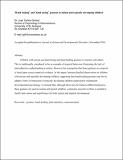Files in this item
Hand leading and hand taking gestures in autism and typically developing children
Item metadata
| dc.contributor.author | Gomez, Juan-Carlos | |
| dc.date.accessioned | 2016-01-05T10:04:31Z | |
| dc.date.available | 2016-01-05T10:04:31Z | |
| dc.date.issued | 2015-01 | |
| dc.identifier | 157311589 | |
| dc.identifier | 7f8cdc0e-9105-4631-b7cf-1b690045cec6 | |
| dc.identifier | 000347691700007 | |
| dc.identifier | 84925535652 | |
| dc.identifier.citation | Gomez , J-C 2015 , ' Hand leading and hand taking gestures in autism and typically developing children ' , Journal of Autism and Developmental Disorders , vol. 45 , no. 1 . https://doi.org/10.1007/s10803-014-2305-5 | en |
| dc.identifier.issn | 0162-3257 | |
| dc.identifier.other | ORCID: /0000-0002-0218-9834/work/64361110 | |
| dc.identifier.uri | https://hdl.handle.net/10023/7945 | |
| dc.description | This paper was partly funded by a Grant from the Baverstock Bequest to the School of Psychology and Neuroscience, University of St. Andrews. | en |
| dc.description.abstract | Children with autism use hand taking and hand leading gestures to interact with others. This is traditionally considered to be an example of atypical behaviour illustrating the lack of intersubjective understanding in autism. However the assumption that these gestures are atypical is based upon scarce empirical evidence. In this paper I present detailed observations in children with autism and typically developing children, suggesting that hand-leading gestures may be an adaptive form of interaction in typically developing children neglected by mainstream developmental psychology. I conclude that, although there may be features differentiating how these gestures are used in autism and typical children, systematic research on them is needed to clarify their nature and significance for both typical and atypical development. | |
| dc.format.extent | 10 | |
| dc.format.extent | 224916 | |
| dc.language.iso | eng | |
| dc.relation.ispartof | Journal of Autism and Developmental Disorders | en |
| dc.subject | Gestures | en |
| dc.subject | hand-leading | en |
| dc.subject | ,Joint attention | en |
| dc.subject | Communication | en |
| dc.subject | BF Psychology | en |
| dc.subject | NDAS | en |
| dc.subject.lcc | BF | en |
| dc.title | Hand leading and hand taking gestures in autism and typically developing children | en |
| dc.type | Journal article | en |
| dc.contributor.institution | University of St Andrews. School of Psychology and Neuroscience | en |
| dc.contributor.institution | University of St Andrews. Institute of Behavioural and Neural Sciences | en |
| dc.contributor.institution | University of St Andrews. Centre for Social Learning & Cognitive Evolution | en |
| dc.identifier.doi | https://doi.org/10.1007/s10803-014-2305-5 | |
| dc.description.status | Peer reviewed | en |
| dc.date.embargoedUntil | 2016-01-01 |
This item appears in the following Collection(s)
Items in the St Andrews Research Repository are protected by copyright, with all rights reserved, unless otherwise indicated.

